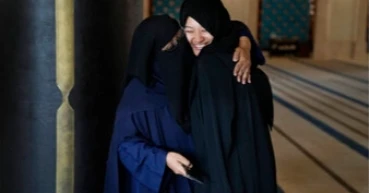Visitors
Visitors banned from entering secretariat on Mondays, Thursdays
The government has imposed a ban on visitor entry to the Bangladesh Secretariat on Mondays and Thursdays every week, effective immediately.
The Public Security Division of the Ministry of Home Affairs issued a notification to this effect on Wednesday (May 28).
Secretariat employees stage one-hour work abstention
“Considering the meeting of the Advisory Council and overall matters, entry of all types of visitors into the Bangladesh Secretariat will remain suspended every Monday and Thursday of each week until further notice,” the notice reads.
7 months ago
Hatirjheel: From scenic spot to a place of fear
Hatirjheel, a scenic lake in Dhaka celebrated for its picturesque views and bustling crowds, is increasingly becoming synonymous with fear and crime.
While it remains a favoured destination for families, couples and tourists, the area’s darker side has drawn growing concern.
A visit to Hatirjheel and conversations with visitors revealed a mix of admiration for its beauty and apprehension about safety.
Raihan Masud, a resident of Badda, often visits the lake with his young child.
“My child enjoys coming here on weekends, so I bring them during the day. However, the area feels unsafe, especially after dark. We often hear of thefts and muggings, so we leave before nightfall,” he shared.
For some, the fear is closer to home.
A local resident, speaking anonymously, recounted a burglary in their neighbourhood.
“The house opposite mine was robbed one evening before the owners returned from work. We heard their screams and found the house ransacked. The thieves fled before taking anything, likely out of fear of being caught,” he said.
As evening descends on Hatirjheel, certain areas become eerily quiet.
Read: Police rescue kidnapping victim in Hatirjheel, arrest three suspects
Teenagers and middle-aged individuals gather in groups, but interactions with them often elicit evasive or hostile responses.
Local vendors, who operate until around 11 pm, say the atmosphere changes late at night.
“Drug use and muggings start happening after we leave,” one vendor explained.
Police Perspective
Inspector Raju Ahmed of Hatirjheel Police Station confirmed that the area faces persistent crime.
“Hatirjheel is a hotspot for theft and mugging. Most perpetrators are drug addicts, often unemployed and from lower-income backgrounds. These crimes are easier for them to commit given the area’s dense population and economic disparity,” he said.
Inspector Ahmed also pointed to the prevalence of drug use in Hatirjheel. “The majority of addicts here consume marijuana, including teenagers, rickshaw pullers, and even wealthier individuals who arrive in cars to drink alcohol. While large drug shipments are rare, small-scale dealing is common. We detain those we catch red-handed, but large-scale arrests are limited.”
A Cycle of Arrests and Bail
The police claim to make hundreds of arrests daily. “By morning, our cells are full of those detained for drug use or loitering.
Read more: Body of Gazi TV’s newsroom editor recovered from Hatirjheel Lake
But most of them secure bail quickly, including individuals previously involved in major crimes. Their associates often continue criminal activities like theft and mugging,” Ahmed added.
Despite recognising the area’s vulnerabilities, the police have yet to officially declare Hatirjheel a crime hotspot.
“We analyse crime patterns to guide our operations, but no formal designation has been made,” Ahmed said.
A Six-Month Snapshot of Crime
According to police data, the last six months have seen 19 murders, four rapes, 23 thefts, 16 suicides, and six muggings in the Hatirjheel area.
While no bodies have been found in public spaces, these crimes often occur in nearby homes, with investigations ongoing.
“We are working to uncover the root causes of these incidents and take appropriate action,” the police officer said.
Hatirjheel’s transformation from a serene urban retreat to a feared crime zone is a troubling development for Dhaka’s residents.
For now, locals said, its beauty remains tempered by caution, as visitors weigh the risks of enjoying its charm.
11 months ago
War's longest battle exacts high price in 'heart of Ukraine'
It used to be that visitors would browse through Bakhmut’s late 19th century buildings, enjoy walks in its rose-lined lakeside park and revel in the sparkling wines produced in historic underground caves. That was when this city in eastern Ukraine was a popular tourist destination.
No more. The longest battle of Russia's war has turned this city of salt and gypsum mines into a ghost town. Despite bombing, shelling and attempts to encircle Bakhmut for six months, Russia's forces have not conquered it.
But their scorched-earth tactics have made it impossible for civilians to have any semblance of a life there.
“It’s hell on earth right now; I can’t find enough words to describe it,” said Ukrainian soldier Petro Voloschenko, who is known on the battlefield as Stone, his voice rising with emotion and resentment.
Voloschenko, who is originally from Kyiv, arrived in the area in August when the Russian assault started and has since celebrated his birthday, Christmas and New Year’s there.
The 44-year-old saw the city, located around 100 kilometers (60 miles) from Russia’s border, gradually turned into a wasteland of ruins. Most of the houses are crushed, without roofs, ceilings, windows or doors, making them uninhabitable, he said.
Out of a prewar population of 80,000, a few thousand residents remain. They rarely see daylight because they spend most of their time in basements sheltering from the ferocious fighting around and above them. The city constantly shudders with the muffled sound of explosions, the whizzing of mortars and a constant soundtrack of artillery. Anywhere is a potential target.
Bakhmut lies in Donetsk province, one of four that Russia illegally annexed in the fall — but Moscow only controls about half of it. To take the remaining half, Russian forces have no choice but to go through Bakhmut, which offers the only approach to bigger Ukrainian-held cities since Ukrainian troops took back Izium in Kharkiv province in September, according to Mykola Bielieskov, a research fellow at Ukraine’s National Institute for Strategic Studies.
“Without seizure of these cities, the Russian army won’t be able to accomplish the political task it was given,” Bielieskov said.
The deterioration in Bakhmut started during the summer after Russia took the last major city in neighboring Luhansk province. It then poured troops and equipment into capturing Bakhmut, and Ukraine did the same to defend it. For Russia, the city was one stepping stone toward its goal of seizing the remaining Ukrainian-held territory in Donetsk.
From trenches outside the city, the two sides dug in for what turned into an exhausting standoff as Ukraine clawed back territory to the north and south and Russian airstrikes across the country targeted power plants and other infrastructure.
Read more: Ukraine conflict casts shadow on Russia as it enters 2023
The months of battle exhausted both armies. In the fall, Russia changed tactics and sent in foot soldiers instead of probing the front line mainly with artillery, according to Voloschenko.
Bielieskov, the research fellow, said the least-trained Russians go first to force the Ukrainians to open fire and expose the strengths and weaknesses of their defense.
More trained units or mercenaries from the Wagner Group, a private Russian military company led by a rogue millionaire and known for its brutality, make up the rear guard, Bielieskov said.
Bielieskov said that Ukraine compensates for its lack of heavy equipment with people who are ready to stand to the last.
"Lightly armed, without sufficient artillery support, which they cannot always be provided, they stand and hold off attacks as long as possible,” he said.
The result is that the battle is believed to have produced horrific troop losses for both Ukraine and Russia. Quite how deadly isn’t known: Neither side is saying.
“Manpower is less of a Russian problem and, in some ways, more of a Ukrainian problem, not only because the casualties are painful, but they’re often ... Ukraine’s best troops,” said Lawrence Freedman, a professor emeritus of war studies at King’s College London.
The Institute for the Study of War recently reported that Wagner forces have seen more than 4,100 die and 10,000 wounded, including over 1,000 killed between late November and early December near Bakhmut. The numbers are impossible to verify.
Ukrainian President Volodymyr Zelenskyy, in a recent address, described the situation in Bakhmut as “very tough.”
“These are constant Russian assaults. Constant attempts to break through our defenses” he said,
Like Mariupol — the port city in the same province that Russia eventually captured after an 82-day siege that eventually came down to a mammoth steel mill where determined Ukrainian fighters held out along with civilians — Bakhmut has taken on almost mythic importance to its defenders.
“Bakhmut has already become a symbol of Ukrainian invincibility,” Voloschenko said. “Bakhmut is the heart of Ukraine, and the future peace of those cities that are no longer under occupation depends on the rhythm with which it beats.”
For now, Bakhmut remains completely under the control of the Ukrainian army, albeit more as a fortress than a place where people would visit, work or love. In January, the Russians seized the town of Soledar, located less than 20 kilometers (some 12 miles) away, but their advance is very slow, according to military analysts.
“These are rates of advancement that do not allow us to talk about serious offensive actions. It’s a slow pushing out at a very high price,” Bielieskov said.
Along the front line on the Ukrainian side, emergency medical units provide urgent care to battlefield casualties. From 50 to 170 wounded Ukrainian soldiers pass daily through just one of the several stabilization points along the Donetsk front line, according to Tetiana Ivanchenko, who has volunteered in eastern Ukraine since a Russia-backed separatist conflict started there in 2014.
After its setbacks in Kharkiv in the northeast and Kherson province in the south, the Kremlin is hungry for any success, even if it is just seizing a town or two that have been pounded into rubble. Freedman, the King’s College London professor emeritus, said the loss of Bakhmut would be a blow for Ukraine and offer tactical advantages to Russian forces, but wouldn't prove decisive to the outcome of the war.
There would have been more value for Russia if it could have captured a populated and intact Bakhmut early on in the war, but now the capture would just give its forces options on how to seize more of Donetsk, said Freedman.
A 22-year-old Ukrainian soldier who is known as Desiatyi, or Tenth, joined the army on the day that Russia started the full-scale war in Ukraine. After months spent defending the Bakhmut area, losing many comrades, he said he has no regrets.
“It is not about comparing the price and losses on both sides. It’s about the fact that, yes, Ukrainians are dying, but they are dying because of a specific goal,” said Desiatyi, who did not give his real name for security reasons.
“Ukraine has no choice but to defend every inch of its land. The country must defend itself, especially now, so zealously, so firmly, and desperately. This is what will help us liberate our occupied territories in the future.”
2 years ago
Bangabhaban is now open for visitors on a limited scale
The presidential house Bangabhaban is now open for visitors on a limited scale.
President Abdul Hamid said after inaugurating the renovated Air Raid Shelter and Bangabhaban Toshakhana Museum on Tuesday afternoon.
"People usually can't enter Bangabhaban. Nobody knows what's inside, it's in the darkness," he said. "People will also know the history and tradition of Bangabhaban.”
Terming the Bangabhaban Toshakhana Museum as one of the monuments of centuries of colorful history and tradition of the Bengalis, the President said, "I believe, the Bangabhaban Toshakhana Museum will play an important role in preserving the rich history of Bangabhaban and presenting it to the future generations."
Hamid said the foreign envoys or ambassadors and visitors would be able to get acquainted with the country's history, heritage and culture during their visit.
The people will also be attracted by visiting many installations of Bangabhaban, and subsequently their attitude towards Bangladesh would be very positive, the President added.
Bangabhaban was once called 'Manuk House'. After that, it was regarded as Governor House. A unique combination of Victorian architecture with Islamic and Bengali architecture, this building is now the office and residence of the President of the Republic.
Various schemes are being implemented including modernisation of Toshakhana and Air Raid Shelter House and construction of a walkway with the aim of opening the Bangabhaban to local and foreign visitors in a limited scale.
In the afternoon, President Hamid inaugurated the newly constructed Toshakhana Museum and visited the installations at different rooms there.
Under the overall supervision of Bangabhaban, this dilapidated Toshakhana was elevated into a museum with a modern look.
The Toshakhana houses are decorated with the gifts from different heads of states and governments of different countries across the world.
Apart from the opening for domestic and foreign visitors on a limited basis, the initiatives have been taken so that anyone can visit the Toshakhana online from any part of the world and learn about Bangabhaban.
Earlier, President Hamid planted a sibling there after inaugurating the renovated Air Raid Shelter House.
Due to lack of use, this abandoned shelter built in 1965 was taken as a historical monument for the visitors coming to Bangabhaban. The Air Raid Shelter House has been renovated in its original shape.
Besides the modern landscaped, Bangabhaban has beautiful green gardens, Dumba Shed, Deer Park, four nicely arranged ponds and a swimming pool.
President's wife Rashida Khanam, State Minister for Cultural Affairs KM Khalid, State Minister for Housing and Public Works Sharif Ahmed, State Minister for Information and Communication Technology Zunaid Ahmed Palak, Rezwan Ahammad Taufiq MP and secretaries concerned and high civil and military officers accompanied the President at the event.
2 years ago
Qatar offers World Cup visitors an introduction to Islam
Fatima Garcia donned a headscarf and a black abaya — a long, loose-fitting robe — over her clothes as she walked into a mosque in Doha to learn about Islam.
In Qatar to enjoy the World Cup with friends, the Salvadoran visitor took a day off from soccer to go sightseeing at the Katara mosque, where preachers have been introducing Islam in multiple languages to curious fans from around the world.
“Qatar is my first exposure to Islam,” Garcia said inside the house of prayer, also known as the blue mosque for its beautiful turquoise tiles. “Qatar has been a life-changing adventure because it gives you a perspective on different cultures.”
Hundreds of thousands of visitors have come to Qatar during the World Cup. For many it's their first visit to a Muslim country. Those who don't venture far beyond the stadiums and Doha's glitzy hotels will have only limited exposure to the country's religion, such as hearing the call to prayer at a distance or witnessing Muslims prostrate at prayer rooms in stadiums, airports and hotels. But for those who are curious to find out more about Islam, Qatari authorities and religious officials are eager to help.
Local mosques are offering multilingual tours to visitors and the Islamic Cultural Center in Doha offers a virtual reality tour of the holy city of Mecca. Booths at tourist sites hand out free copies of the Quran and brochures about Islam are available in hotel lobbies. Billboards have been set up across Doha featuring U.S. Olympic fencer Ibtihaj Muhammed and other Muslim personalities as part of a campaign encouraging people to explore Islam.
“Why during the World Cup? Everyone is coming here from across the world to Qatar, a Muslim country, and it’s an opportunity to educate people about the faith,” said Abu Huraira, a volunteer for the campaign by the Explore Islam Foundation and the Islam & Muslims Initiative.
Qatari officials say they hope the tournament will help provide visitors with a better understanding of their culture and that of the larger region.
Qatar follows an ultraconservative form of Sunni Islam known as Wahhabism. But unlike neighboring Saudi Arabia, where adherence to Wahhabism led to strict segregation of unmarried men and women, banned women from driving and kept concerts, cinemas and even yoga off-limits for decades, Qatar has long sponsored the arts, allowed women to participate in high levels of governance and encouraged tourists to feel at ease.
The World Cup host, though, has faced intense criticism over human rights issues, including the treatment of migrant workers, and accusations of “sportswashing” or attempting to use the event’s prestige to remake its image.
Qatari officials have argued that the nation’s progress and achievements are being overlooked. The ruling emir, Sheikh Tamim bin Hamad Al Thani, said some of the criticism against the first Arab and Muslim country to host the World Cup included “fabrications and double standards.”
The Ministry of Endowments and Islamic Affairs and the host country’s Supreme Committee for Delivery and Legacy did not respond to requests for comment.
Read more: FIFA World Cup 2022: All you need to know about Qatar's laws, customs
Back inside the ornate Ottoman-style Katara mosque, Riffat Ishfaq, a guide from Pakistan, told Garcia that it was designed by Turkish interior designer Zeynep Fadillioglu, whose first name is the Turkish form of the name of the eldest daughter of the Prophet Muhammed. The tiles had been handmade, Ishfaq said; the columns were covered with leather and the domed roof contained gold. By the end of the tour, Garcia also learned why women dress modestly in Islam and the origins of the religion.
“We want to tell people about Islam. We feel pride in our identity,” Ishfaq said, before telling Garcia to keep the abaya as a parting gift. “This helps to dispel misconceptions.”
Nearby, Sergio Morales, a Guatemalan who had come for the whole tournament, finished listening to a tour and walked out of the mosque to a booth located at the entrance where he asked for a free copy of the Quran.
“Today I became interested because the guided tour was in Spanish and I could understand it all,” he said. “There should be guides in Spanish in every mosque because there are so many Latin American people coming to these countries.”
Booths with free Qurans and booklets introducing the religion in several languages are also available in the winding cobbled alleys of Souq Waqif, the capital’s oldest bazaar where stores hawk spices and perfumes, scented oils and silk scarves.
Just steps from there, World Cup visitors walked into the spiral-like building of the Abdullah Bin Zaid Al-Mahmoud Islamic Cultural Center, for a tour and a visit to the mosque, where people gathered for Friday prayer.
Carlos Bustos, Mireya Arias and their sons, 8-year-old Jacobo and 13-year-old Matias toured the cultural center. The Colombian family read information on large placards about the contributions of the Islamic world to medicine, science, math and architecture.
“What we've seen is that they've made an effort to change the image that we have in the West of seeing Islam. It's breaking that barrier,” said Carlos Bustos, who along with his sons had dressed in traditional Qatari clothes.
“They've told us that we're very different but we see more similarities than differences,” he said.
His wife, Mireya Arias, admired the devotion of Muslims to their faith and how they follow the call to prayer. She also appreciated the efforts made by Qatar to introduce visitors to Islam.
Read more: Qatar ready to open Mideast’s first FIFA World Cup before leaders, fans
“They've used a lot of strategies to get closer to visitors, for us to understand and learn,” she said. “When you're on the buses that take you to the (World Cup) stadiums, you point to a QR code and it gives you explanations about the Quran.”
Doha’s Museum of Islamic Art also offers glimpses into religious beliefs and rituals. Visitors can read about the five pillars of Islam — the profession of faith, prayer, almsgiving, fasting and hajj or pilgrimage — or learn about hajj rituals and different funerary practices in the Islamic world.
“The more you understand this Islamic culture, the more fascinating it is,” said Jose Antonio Tinoco, a Brazilian museum visitor, who wore his country's soccer jersey. “The most important part of the museum for me was the part on Islam.”
3 years ago
Visitors’ turnout still low at trade fair
Although 13 days have passed by, the 25th edition of Dhaka International Trade Fair (DITF) is yet to gain momentum due to poor turnout of buyers and visitors.
5 years ago











